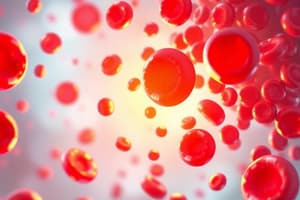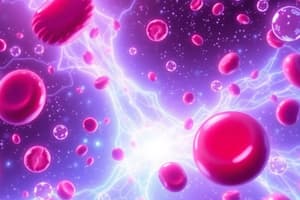Podcast
Questions and Answers
What is the typical onset time for HIT II?
What is the typical onset time for HIT II?
- 5-14 days after exposure to heparin (correct)
- Within 24 hours of starting heparin
- Within the first two days of heparin exposure
- In the first 100 days after exposure to heparin
Which of the following is NOT a characteristic of HIT type I?
Which of the following is NOT a characteristic of HIT type I?
- Typically occurs within the first two days of heparin exposure
- Platelet count usually returns to normal with discontinued heparin administration
- Has life-and limb-threatening thrombotic complications (correct)
- A mild, transient drop in platelet count
What is the difference between HIT type I and HIT type II?
What is the difference between HIT type I and HIT type II?
- HIT type I is more common than HIT type II.
- HIT type I is a direct effect of heparin on platelets, while HIT type II is an immune-mediated response. (correct)
- HIT type I has life-threatening thrombotic complications, while HIT type II does not.
- HIT type I is immune-mediated, while HIT type II is not.
What is the role of heparin-PF4-IgG complex in HIT?
What is the role of heparin-PF4-IgG complex in HIT?
Which of the following is a possible treatment for HIT?
Which of the following is a possible treatment for HIT?
What is 'Rapid-onset HIT'?
What is 'Rapid-onset HIT'?
What is the relationship between heparin purity and the risk of HIT?
What is the relationship between heparin purity and the risk of HIT?
Which of the following is a diagnostic test for HIT?
Which of the following is a diagnostic test for HIT?
What is the primary function of heparin in the context of blood clotting?
What is the primary function of heparin in the context of blood clotting?
Heparin's mechanism of action involves the activation of which molecule?
Heparin's mechanism of action involves the activation of which molecule?
Which of the following is NOT a potential side effect of heparin treatment?
Which of the following is NOT a potential side effect of heparin treatment?
How does heparin become a procoagulant in the case of HIT?
How does heparin become a procoagulant in the case of HIT?
What is the primary concern regarding heparin use in patients with HIT?
What is the primary concern regarding heparin use in patients with HIT?
Why is regular monitoring of platelet count crucial in patients receiving heparin therapy?
Why is regular monitoring of platelet count crucial in patients receiving heparin therapy?
When is HIT suspected in a patient on heparin therapy?
When is HIT suspected in a patient on heparin therapy?
What key factor differentiates heparin from other anticoagulants in terms of its administration?
What key factor differentiates heparin from other anticoagulants in terms of its administration?
What is the specific immune response involved in the pathogenesis of heparin-induced thrombocytopenia (HIT)?
What is the specific immune response involved in the pathogenesis of heparin-induced thrombocytopenia (HIT)?
Which of the following clinical manifestations is MOST commonly associated with HIT?
Which of the following clinical manifestations is MOST commonly associated with HIT?
How does heparin contribute to the development of HIT?
How does heparin contribute to the development of HIT?
What is the specific role of the heparin-PF4 complex in the pathogenesis of HIT?
What is the specific role of the heparin-PF4 complex in the pathogenesis of HIT?
What is the significance of the 4T score in the diagnosis of HIT?
What is the significance of the 4T score in the diagnosis of HIT?
What is the primary mechanism by which HIT leads to thrombocytopenia?
What is the primary mechanism by which HIT leads to thrombocytopenia?
Which of the following diagnostic tests is the MOST definitive for the diagnosis of HIT?
Which of the following diagnostic tests is the MOST definitive for the diagnosis of HIT?
Which of the following statements regarding the timing of HIT development is TRUE?
Which of the following statements regarding the timing of HIT development is TRUE?
Flashcards
Heparin
Heparin
An anticoagulant that inhibits thrombin activity and prevents clot formation.
Antithrombin III
Antithrombin III
A protein that inactivates thrombin and factor Xa, thus inhibiting clotting.
Thrombin
Thrombin
An enzyme that converts fibrinogen to fibrin, crucial for clot formation.
Fibrinogen
Fibrinogen
Signup and view all the flashcards
Heparin Induced Thrombocytopenia (HIT)
Heparin Induced Thrombocytopenia (HIT)
Signup and view all the flashcards
Thrombocytopenia
Thrombocytopenia
Signup and view all the flashcards
Pro-coagulant effect of heparin in HIT
Pro-coagulant effect of heparin in HIT
Signup and view all the flashcards
Monitoring Platelet Count with Heparin
Monitoring Platelet Count with Heparin
Signup and view all the flashcards
Type I HIT
Type I HIT
Signup and view all the flashcards
Type II HIT
Type II HIT
Signup and view all the flashcards
HIT diagnosis
HIT diagnosis
Signup and view all the flashcards
Serotonin release assay
Serotonin release assay
Signup and view all the flashcards
Alternative anticoagulant
Alternative anticoagulant
Signup and view all the flashcards
Thrombosis
Thrombosis
Signup and view all the flashcards
Platelet transfusion
Platelet transfusion
Signup and view all the flashcards
Delayed-onset HIT
Delayed-onset HIT
Signup and view all the flashcards
Heparin-PF4 complex
Heparin-PF4 complex
Signup and view all the flashcards
IgG antibodies
IgG antibodies
Signup and view all the flashcards
Hypercoagulable state
Hypercoagulable state
Signup and view all the flashcards
4T Score
4T Score
Signup and view all the flashcards
Anti-PF4 test
Anti-PF4 test
Signup and view all the flashcards
Study Notes
Heparin-Induced Thrombocytopenia (HIT)
- HIT is a life-threatening complication of heparin exposure, occurring in patients regardless of dose, schedule, or administration route.
- Heparin is administered as unfractionated heparin (UFH) or low molecular weight (LMWH) heparin.
- HIT is more common with UFH than LMWH due to UFH's greater immunogenic property and greater cross-reactivity with PF4.
Types of HIT
-
HIT Type I (non-immune):
- Mild, transient decrease in platelet count (typically within the first two days of heparin exposure).
- Platelet count returns to normal with heparin discontinuation.
- Direct non-immune-mediated platelet aggregation effect of heparin.
- Not clinically significant.
-
HIT Type II (immune-mediated):
- An immune-mediated disorder occurring 5-14 days after heparin exposure.
- Characterized by potentially life-threatening thrombotic complications.
- Three subtypes: Rapid-, Typical-, and Delayed-onset
- Rapid-onset: Platelet count drop within 24 hours of starting heparin (pre-existing heparin exposure within the last 100 days)
- Typical-onset: Onset 5-14 days after starting heparin
- Delayed-onset: HIT symptoms develop up to three weeks after heparin discontinuation.
Pathophysiology of HIT
- Heparin binds to platelet factor 4 (PF4), exposing a previously masked immune epitope.
- This leads to the formation of a heparin-PF4 complex.
- The complex triggers the production of immunoglobulin G (IgG) antibodies.
- Antibodies bind to the heparin-PF4 complex, forming circulating immune complexes (CIC).
- CICs bind to the Fc receptor on platelets, inducing platelet activation and aggregation resulting in thrombocytopenia and thrombosis.
Clinical Manifestations of HIT
- Hypercoagulable state
- Thrombocytopenia
Complications of HIT
- Deep vein thrombosis (most frequent complication)
- Pulmonary embolism (most frequent complication)
- Myocardial infarction
- Limb artery occlusion (potentially requiring amputation)
- Transient ischemic attack (TIA)
- Stroke
- Skin necrosis
- End-organ damage (e.g., adrenal, bowel, spleen, gallbladder, hepatic infarction, renal failure)
- Death
Diagnosis of HIT
- Clinical scoring (4T score) is used to assess the probability of HIT. Scores range from low, intermediate, to high probability.
- Anti-PF4 antibody enzyme-linked immunosorbent assay (ELISA) test (detects IgG antibodies against the PF4/heparin complex but isn't specific).
- Serotonin release assay (functional assay that measures heparin-dependent platelet activation—better predictor of thrombosis than anti-PF4 assay)
Studying That Suits You
Use AI to generate personalized quizzes and flashcards to suit your learning preferences.





